Science
The Curious Question Of Evolution And Entropy
Mahak Poonia
Mar 16, 2022, 05:50 PM | Updated 12:01 AM IST
Save & read from anywhere!
Bookmark stories for easy access on any device or the Swarajya app.


the beginning and the end
S=k ln(W)
the entropy of the universe always increases
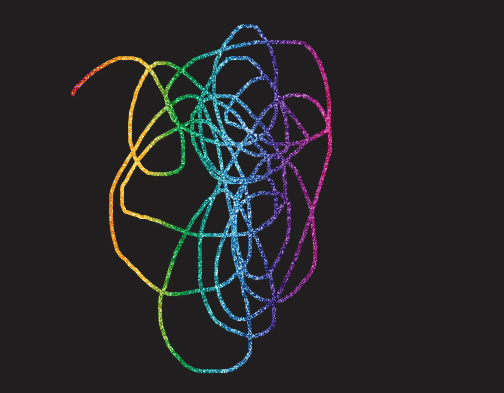
This equation, and law, are familiar to every physics student and contain the crux of thermodynamics, a vast field with a large number of physical and theoretical applications.
Thermodynamics is known to be one of the most ‘physical’ (in the sense of its many varied and important applications) and one of the most abstract of all scientific disciplines. We know the laws and engineers apply them. The father of thermodynamics is, after all, a brilliant engineer, Nicolas Léonard Sadi Carnot.
At the same time, thermodynamics intrigues many because of its abstractness, the many laws it has, and how much they reveal and obscure about our world. One of the most fascinating of these topics is entropy.
Entropy has numerous definitions, and each one of us likes to think of it in our own way. We know it is a state function. We know its change is zero over a reversible cycle. And we know it contains its own definition of the second law of thermodynamics. It is the measure of disorder in a system. It is the measure of the information in a system. It defines the arrow of time.
Entropy change has a clean formula for the Carnot engine and finds many applications, principally those determining the efficiency of engines and processes.
The question of what entropy is, is difficult to answer to everyone’s satisfaction, so let’s not dwell on that. Let’s instead dive into one particular definition of it and how it leads to natural processes being as they are.
For us, entropy is a measure of the disorder in a system, and mathematically S=k ln(W) for a given configuration, where:
W is the multiplicity of the configuration (the number of microstates that correspond to it),
k is the Boltzmann constant,
S is entropy.
For our purposes, it suffices to consider W to be a measure of the probability of a certain configuration of a system of particles (that is, the number of ways that the state can be achieved or exists).
Mathematically, W=N!/n1!*n2!*n3!…….nn!, where:
N is the total number of particles, and
n1, n2… denote the numbers of particles existing in different parts of the system, where n1+n2+…..+nn=N.
Consider a cuboid, divided into two halves by a removable partition. Let one half contain blue gas molecules and the other, orange gas molecules. Right now, the particles have a certain number of ways in which they can exist, say x1. In one half, 10 orange molecules could be in one corner, the rest in the others. There can be many such arrangements, their number increasing with the number of molecules.
Suppose that we know the total number of their configurations (we don’t need to consider the number of microstates accompanying each of them for present purposes). Now, remove the partition. Gases, being as wiggly as they are, mix up.
In a similar way as above, the particles have many different ways of existing together. Since their total number (orange + blue) and the volume they occupy have increased (V/2+V/2=V), the total number of ways the particles can now exist with one another has also increased to, say, x2.
x2>x1, which implies, according to our equation, that entropy after the partition was removed is more than when the blue and orange gas molecules were separated.
And, clearly, the order that existed with the molecules separated has been lost.
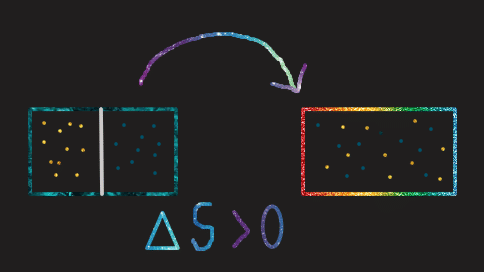
So, as disorder increases, entropy increases. And the second law states that the entropy of the universe must always increase. This implies that the disorder of the universe must always increase.
But then, why and how did organisms become gradually more ordered? From unicellular to multicellular and, as we go up the evolution ladder, a clear organisation of living beings has been in progress.
And how did the planets form, then? Why did debris scattered around the universe decide to come together? Doesn’t that defy the law?

There are a lot of names, theories, and concepts that come up in trying to answer these questions. Here, I’ll attend to the first aspect.
Life, many would agree, is a baffling phenomenon. The greatest mystery life presents us with is life itself. The greatest trick nature plays with us is its manifestation. The greatest magician is the mystery. How does one begin to make sense of it?
We discovered our laws, we established our principles. The beauty is the continuation of this quest of understanding, the fact that it is never ending.
The mystery of the existence of life becomes even more notorious when we understand the principle that, simply stated, contradicts it. This is what was thought when the second law of thermodynamics and what it implies for our world was first understood. But nature, unsurprisingly, has more in store than just the law of entropy.

The law, of course, is deduced from extensive experiments and painstaking work by scientists and engineers and is true in every system we can observe. It is true for life as well, because life exists and the universe’s entropy is increasing. The only problem is the manifestation of this law and the ‘how’ part of it.
Many scientists have sought to understand it, and here we’ll focus on the work of two in particular, Erwin Schrödinger and Jeremy England.
In 1944, Schrödinger published a short classic, titled What is Life?, considered to be one of the most important texts of the last century, both for the fundamentality of the question it explores and its multidisciplinary approach.
A physicist, after all, was trying to answer a question concerning every scientific and intellectual discipline that has existed, a very brave and humble attempt.
The book talks about everything from the size of atoms to the various laws of biology and physics in the living organism… and about entropy. Chapter 6 of the book, titled ‘Order, Disorder and Entropy’, is the most relevant to our question.
Since W in our equation of S is a measure of disorder, Schrödinger proposes that 1/W is a measure of order. Plugging this into our equation yields:
S=-k ln(W), or
-S= k ln(W)
This is Schrödinger’s negative entropy and forms the basis of his explanation. He proposes that we take this negative entropy from the universe and create order, dissipating a large amount of heat in the process, thus greatly increasing the universe’s entropy, in agreement with the second law.
What we take as food is nothing but a highly ordered organic substance, containing a lot of energy and ‘negative entropy’, that is, order.
The food we take gives us the energy we need for carrying out the various metabolic processes and provides us with the negative entropy needed to maintain order in ourselves and, thus, stay alive.
Life works continuously to avoid its rapid decay into the state of thermodynamic equilibrium, that is, of maximum entropy. The massive amount of heat (and, hence, entropy) generated as a result of these processes and existence is more than this factor of negative entropy.
Quoting from Schrödinger’s book: “That we give off heat is not accidental, but essential. For this is precisely the manner in which we dispose of the surplus entropy we continually produce in our physical life process."
In fact, the amount of entropy we generate due to the fact that we are alive is much more than what an unordered group of carbon atoms would. Could this be why we are alive? Does nature need life to achieve its state of maximum entropy?
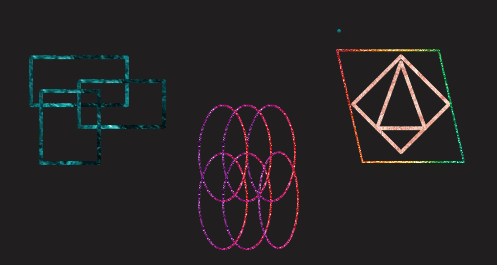
Schrödinger talks about two ways of creating order, either from disorder or, as in the case of life, from order itself. He states, “We witness the event that existing order displays the power of maintaining itself and of producing orderly events.”
What we gain from Schrödinger’s book is brilliant insight into how things might be happening and a possible way in which life manifests one of its numerous facets.
Next: what if we go back in time? To the time when life, as we know it, didn’t exist. This is where Jeremy England’s work comes into play.
Taking ideas from time reversal symmetry, the extended second law, and scientists who came before him, England has sought to put forth ideas to help scientists and engineers understand the mechanisms of life.
He argues, like many physicists before him, that thermodynamics is fundamental to our understanding of life and its existence and an important field from which an explanation for existence can sprout.
He proposes to establish that the second law is, contrary to the general view, in favour of life and, in many ways, enables it.
Through the use of a formula on time reversal symmetry discovered by Gavin Crooks in 1999, he has proposed that for a system driven by an external drive, the likely paths carrying the system from an initial to a final state will have exceptionally positive values of the heat released during them. The more irreversible a process is, the more heat it will dissipate and the more work it will absorb.
Over time, the system increasingly adopts shapes that resemble those in its history when dissipation occurred. In the end, the structures under consideration will appear to have organised themselves in a state that is well adapted to the environmental conditions.
The more likely outcomes of evolution are going to be those systems that absorb and dissipate more and more energy from their surroundings. This is called dissipative adaptation. This theory supports life, since the complex order it consists of is capable of dissipating more heat than what an unordered cluster of atoms would. This suggests that life, instead of being in contradiction to thermodynamic laws, might instead be a consequence of them.
Stated briefly, formulas derived by England state that taking a group of atoms, an energy source that drives them, and a heat reservoir, chances are high that these atoms will come together and form structures that will dissipate increasingly more energy.
Considering the nascent earth — its energy source being the sun, and the oceans and atmosphere being its heat reservoirs — it could have happened that the atoms existing in their very disordered forms came together and formed structures.
England’s work states that this happens because of the second law. The law drives atoms into forming more and more ordered and complex structures because that would lead to a much greater dissipation of energy and, hence, a greater increase in entropy and absorption of work compared to a disordered bunch of atoms.
Compared to Schrödinger’s proposal, England’s work is about order being created from disorder.
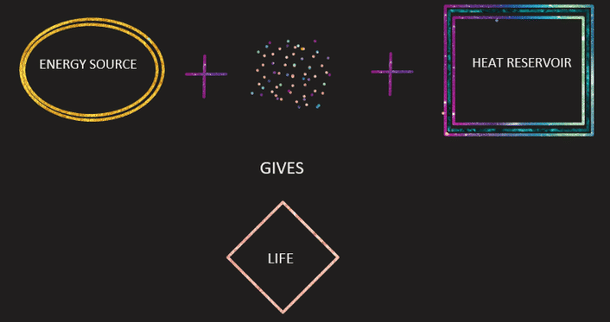
A very simple example would be that of the difference between a group of carbon atoms and the leaf of a living plant.
The leaf is able to assimilate energy from the sun and create food for itself. The sunlight, after reflecting from its surface, is infrared, a much more dispersed form of energy than sunlight. Because of this dispersion of sunlight, photosynthesis leads to an increase in the universe’s entropy, despite creating and maintaining brilliantly ordered systems within itself.
According to England, this is why the universe favours life and seeks to create order from sheer disorder.
England’s work is pioneering, for it tries to account all of life with the second law. Computer simulations based on his model affirm his results and push us to dig deeper. Entropy doesn’t just define the arrow of time, it is possibly what makes life happen.
Both of these scientists have their own ways of explaining aspects of life, one starting from order and the other from disorder. Both of their theories, however, set forth towards the same end: order and, hence, life.
Quoting once again from Schrödinger’s book: “Life seems to be an orderly and lawful behavior of matter, not based exclusively on its tendency to go over from order to disorder, but based partly on existing order that is kept up.”
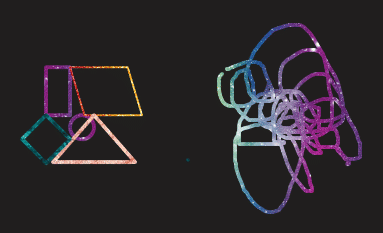
We started with the question of how life is possible when the second law ‘contradicts’ it. What we end with is the insight that this is a misconception. Scientists are working on understanding the ‘hows’ of life and the knowledge they gain is beneficial both for the practical world and for our inherent curiosity.
Something as real as life takes an abstract stance sometimes and raises ever more questions with every new bit of knowledge gained. Many of the answers we are looking for are hidden around us and sometimes require excellent scientific calibre in order to be discovered.
Since ages, life has eluded us. Since ages, life has craved its understanding.
Writer's Note: Find more of J England’s work here. Another intriguing paper on the subject can be found here. A crude description of entropy’s statistical description was given here. Far better resources would be intermediary textbooks on thermodynamics.
This article has been published as part of Swasti 22, the Swarajya Science and Technology Initiative 2022. We are inviting submissions towards the initiative.
Read other Swasti 22 submissions.
I am Mahak Poonia. I love exploring patterns in everything around me and do that through physics and art. I write about many things that help me understand the world better.





